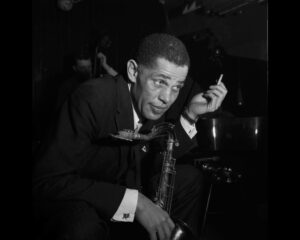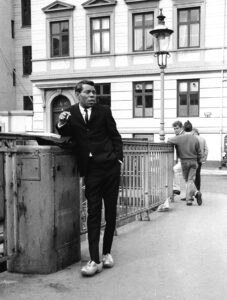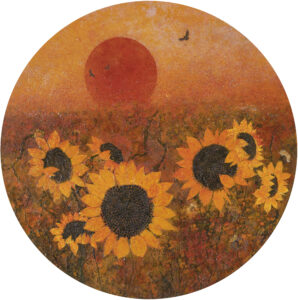On view August 10–November 10, 2024
Love, adventure, educational opportunities, career advancement, sexual exploration and racism are among the myriad reasons African American artists traveled to Nordic countries during the first half of the 20th century. While some visited to learn and perform, others relocated in search of a vastly different life. Nordic Utopia? African Americans in the 20th Century, explores this often-overlooked time. Organized by the National Nordic Museum in Seattle, the exhibition is the first comprehensive pan-Nordic show to illuminate the artists’ motivations and experiences abroad.
Nordic Utopia? assembles drawings, paintings, photographs, textiles, film, music and dance to explore the ways in which travel impacted some African Americans’ visual and performance art. New scholarship chronicles the experiences of singers Josephine Baker and Anne Wiggins Brown; jazz tenor saxophonist Dexter Gordon; dancer and choreographer Doug Crutchfield; painters Herbert Gentry, William Henry Johnson and Walter H. Williams; multimedia artist and designer Howard Smith and others. The objects on view offer insight into their lives, the social climates in which they worked and the reasons they relocated.
“Some artists left the United States on an intentional quest for refuge from racial prejudice and other social constraints. Others found creative freedom in Nordic countries that catapulted their artistic practice,” said exhibition co-curator Ethelene Whitmire, PhD, a professor in the University of Wisconsin–Madison’s Department of African American Studies.
Leslie Anne Anderson, chief curator of the National Nordic Museum, adds, “The stories of African American creatives, journalists and scholars are told through iconic and rarely seen examples of their work held in public and private collections. These objects are brought into a transmedial dialogue with each other that conveys lively cultural exchange.”

Kirsten Malone, “Dexter Gordon at Jazzhus Montmartre in Copenhagen, Denmark,” 1964, gelatin silver print from original. Courtesy of Kirsten Malone.
Danish photographer Kirsten Malone has long captured Denmark’s jazz scene and documented the journeys of several African American artists during their time abroad. Malone’s Dexter Gordon at Jazzhus Montmartre in Copenhagen, Denmark (1964) is among several images of Gordon in the exhibition. The black and white print finds the musician enjoying a quick break during his performance at a club turned musical hub in the Nordic jazz capital. After a successful music career in the United States, Gordon lived in Denmark from 1962–1976.

Kirsten Malone, “A bebop jazz singer. Babs Gonzales in Nyhavn in Copenhagen,” 1968, gelatin silver print from original, Courtesy of Kirsten Malone.
Malone’s A Be-Bop Jazz Singer, Babs Gonzales in Nyhavn in Copenhagen (1968) presents Gonzales in Copenhagen’s Nyhavn entertainment district. Born Lee Brown in Newark, New Jersey, Gonzales split his time between Denmark and Sweden. He also joined the Manhattan Singers in Scandinavia on tour for four months and traveled to Paris. Along with his music, Gonzales self-published several books about some of the struggles Black musicians faced.
Love ultimately drove William Henry Johnson to Scandinavia in the 1930s. The South Carolina native moved to New York as a teen, where he worked several jobs to pay for studies at the National Academy of Design. After reaching acclaim as a talented painter in school, Johnson went to France, where he explored modernism and found love in Danish artist Holcha Krake. The two married and lived in Scandinavia for approximately eight years. There, Johnson developed an affinity for primitivism and folk art that would impact his painting upon his return to New York in 1938. Over his career, he produced thousands of paintings and works on paper that are held in the Smithsonian American Art Museum’s permanent collection.
Expressionist painter Herbert Gentry spent five years immersed in Copenhagen’s jazz scene, where he was surrounded by African American musicians, writers and artists. His mother, a chorus dancer, introduced Gentry to music and theater during the Harlem Renaissance. Gentry pursued visual arts until World War II derailed his studies. His service in the U.S. Army led him to duty stations in North Africa, Corsica, France, Austria and Germany — exposing him to new cultures, people and places. While stationed in a French suburb, Gentry visited Paris often. After returning to New York in 1945 following an honorable discharge, Gentry saved enough money to be among the first wave of GI Bill art students to arrive in Paris in 1946. During his long career, Gentry lived in Copenhagen, Gothenburg, Stockholm and Paris. While in Copenhagen, the dynamic jazz scene greatly influenced his visual arts style, inspiring more improvisation in his abstract works. Then and Now (1964), one of several works by Gentry in the exhibition, bridges the artist’s past and present and hints at what viewers would see in his future works. Gentry returned to New York to live in 1990.

Walter Williams, Sunflowers, n.d., mixed media. Loan courtesy of The Johnson Collection.
Walter H. Williams began traveling to Denmark in 1959 and became a citizen in 1979. He often used nature in his works to represent brighter days for African Americans. During his time in Bornholm, also known as sunshine island, Williams started using sunflowers in his work, as featured in Sunflowers (n.d.) and Southern Landscape (1977-78). Williams studied at the Brooklyn Museum Art School and first experienced living abroad after winning a John Hay Whitney fellowship to study in Mexico. There, he was able to perfect his artistic practice without the racial prejudice that loomed in the United States. After remaining in Mexico for four years, he returned home before traveling to Denmark.
The exhibition draws from several private and public collections across the United States and Nordic countries including the National Gallery of Art and Smithsonian American Art Museum in Washington, DC; the David C. Driskell Center at the University of Maryland, College Park; Moderna Museet in Stockholm and SMK—the National Gallery of Denmark in Copenhagen.
Nordic Utopia? African Americans in the 20th Century is co-curated by Ethelene Whitmire, PhD, a professor in the University of Wisconsin–Madison’s Department of African American Studies, and Leslie Anne Anderson, chief curator at the National Nordic Museum. The exhibition is organized by the National Nordic Museum, Seattle. A fully illustrated catalogue co-edited by Whitmire and Anderson will accompany the exhibition and feature essays by Temi Odumosu, PhD (University of Washington) and Ryan T. Skinner, PhD (Ohio State University).
Support
Generous support for Nordic Utopia? comes from The Terra Foundation for American Art, Laurie Black, Nordisk Kulturfond, Microsoft, Seattle Office of Arts & Culture, The Hugh and Jane Ferguson Foundation, ArtsFund’s Guendolen Carkeek Plestcheeff Fund for the Decorative and Design Arts and Finlandia Foundation National.
About the Curators
Ethelene Whitmire, PhD, is a professor in the Department of African American Studies at the University of Wisconsin–Madison. Whitmire was a Fulbright scholar and a visiting professor at the University of Copenhagen’s Center for Transnational American Studies in 2016–2017. She has received additional fellowships from the American-Scandinavian Foundation and the Lois Roth Endowment.
Leslie Anne Anderson is chief curator of the National Nordic Museum and a Seattle Arts commissioner. She has been an American-Scandinavian Foundation fellow and a Fulbright scholar at the University of Copenhagen. Anderson has organized over 20 exhibitions, including the celebrated collection reinstallation American and Regional Art: Mythmaking and Truth-Telling at the Utah Museum of Fine Arts, and she was the commissioning curator of Jónsi: FLÓÐ for the National Nordic Museum. She has received the international Association of Art Museum Curators Award for Excellence in Exhibition and the Utah Museums Association Award for Excellence.
About the National Nordic Museum
The National Nordic Museum is the only museum in the United States that showcases the impact and influence of Nordic values and innovation in contemporary society and tells the story of 12,000 years of Nordic history and culture across all five Nordic countries (Denmark, Finland, Iceland, Norway and Sweden) as well as three autonomous regions (Greenland, the Faroe Islands, and Åland) and the cultural region of Sápmi. Awarded a national designation by an Act of Congress in 2019, the Museum shares Nordic culture with people of all ages and backgrounds through exhibitions, a collection of 80,000 objects, unique educational and cultural experiences and by serving as a community gathering place.The National Nordic Museum collaborates with institutions in the Nordic countries to present world-class exhibitions. Recent and current exhibition partners include: Ateneum Art Museum, Finnish National Gallery, Helsinki; Nationalmuseum, Stockholm; Nasjonalmuseet, Oslo; and Statens Museum for Kunst, Copenhagen.
For more information, visit: www.nordicmuseum.org.